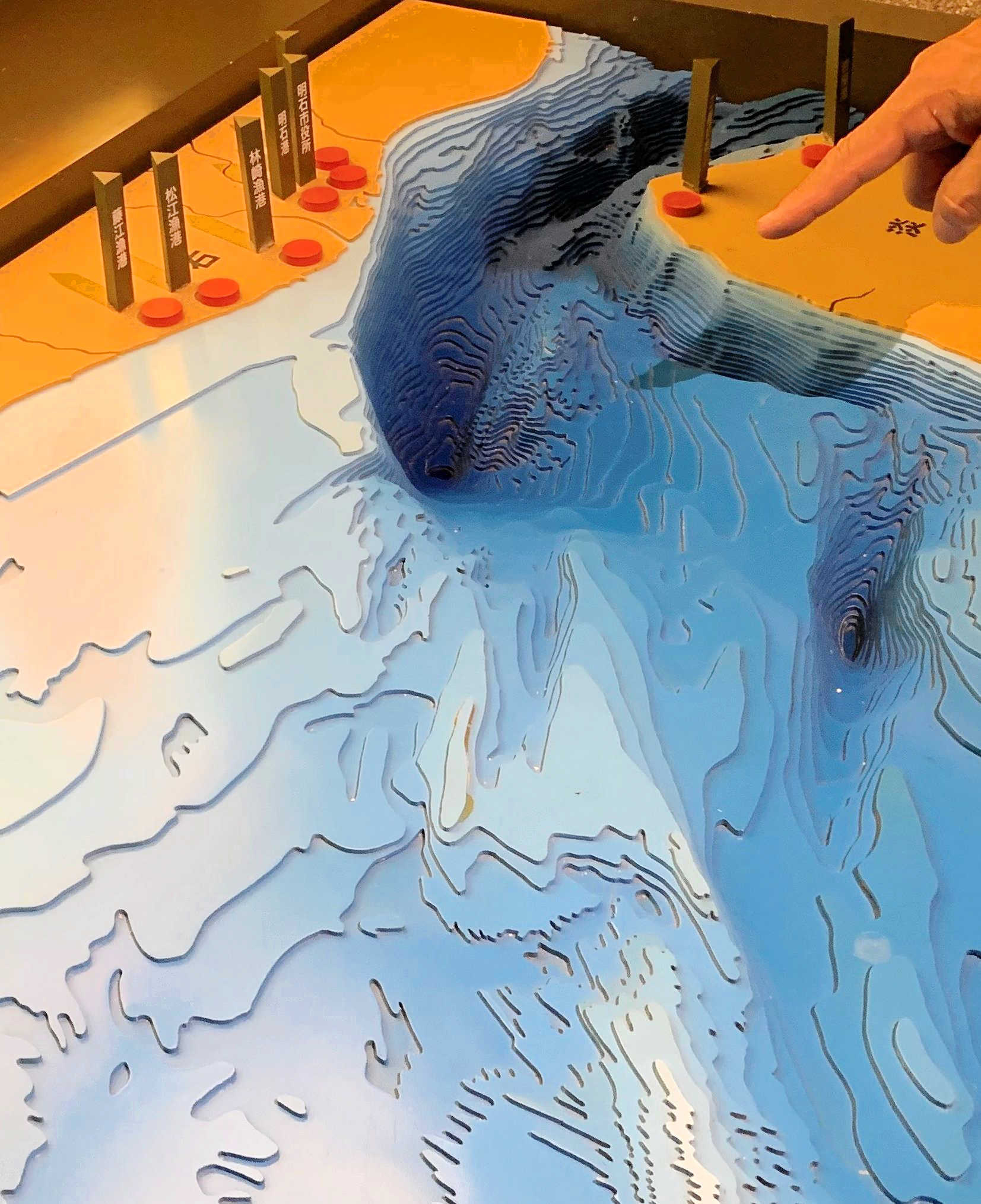Akashi sea bream: “Autumn leaves” nurtured by complex tides
When looking into the hundreds of blue cages floating in the pool with a continuous flow of seawater, one can see flounder, kingfish shrimp, and squid, all caught in the Akashi Strait. Among them, the most extravagant catch is the Akashi red sea bream.

Akashi sea bream with eye catching “eye shadow” and blue beauty spots
In order to survive the winter, Akashi sea bream eat plenty of shrimp and crab, and their fatty flesh gains a reddish hue, earning them the nickname ‘Momijidai’, or autumn leaf colour sea bream. Yusuke Doi of the Akashiura Fisheries Cooperative smiled as he held an Akashi sea bream weighing more than 2 kilograms with a beautiful amber lustre while explaining that “this is worth tens of thousands of yen at retail. It's a fine autumn leaf coloured sea bream”. At Akashiura Fisheries Cooperative Fish Market, most of the fish sold are done so live, which is extremely rare, even in Japan.
Beneath the blue-purple shadow
In the seawater, the blue spots on the red flesh of the Akashi sea bream shine like small jewels. In particular, the female red sea bream, whose eyes shine as if decorated with blue-purple eyeshadow, possess an elegance worthy of the title queen of fish. “It's a special kind of fish, and if it's not just big and fat, but beautiful (even if it's skinny), it can be traded for a high price” Mr. Doi explained about trading conditions unique to Akashi sea bream.
The main fishing technique used is ‘gochiami’ fishing, where the fish are driven into a furoshiki*-like net. When asked, Akiyasu Tsuchii, a fisherman who was transporting Akashi sea bream to the market explained that he chooses “the place to fish depending on the weather that day. Shallow areas are 5 to 7 metres deep, while deeper areas are 60 to 70 meters, the maximum the net can reach”.
*Furoshiki -traditional Japanese wrapping cloths traditionally used to wrap and/or to transport goods.
The sea floor around the Akashi Strait, home to Akashi sea bream, has a very unique topography. There is a model of the ocean floor that clearly shows the topographical structure at the Akashi City Museum of Culture.

Akashi Strait and nearby ocean floor.
Both sides are steep like cliffs, and the whitish area in the foreground is Shikanose = Uenomaru, Akashi City, City Museum of Culture
The dark blue area with narrow contour lines indicates a steep cliff. And in Osaka Bay on the east side of the strait, from the area facing Iwaya Port (Awaji City) on Awaji Island, to the west there is a deep seabed with a hollowed out appearance.
With depths of 149 metres
The deepest part of the Akashi Strait is said to be approximately 149 metres, located in the Harima Sea, just offshore from Akashi’s Hayashizaki Fishing Port and Matsue Fishing Port. To the south, there is also a deep depression off the coast of Toshima Port on Awaji Island. These depressions are called ‘kaifu’ (lit. sea cauldrons) and are often seen in places with strong currents. The area between the two kaifu slopes gently, and the further west you go, the shallower it becomes. The area to the west that looks like a long thin white line is shallow at just a few metres deep, and the bottom can be clearly seen from a boat. The area surrounding this ridge-like shallow water extending southwest is a sandy area known as ‘Shikanose’, and is known as one of the best fishing grounds in the Seto Inland Sea. The landforms, which resemble ocean sand dunes, are said to extend as far as Shodo Island (Kagawa Prefecture). The reason as to why this diverse underwater topography was created is deeply connected to the formation of the Seto Inland Sea. “20,000 years ago, a large river flowed here” Akiyoshi Inahara, Akashi City’s Cultural Properties Division Manager, explained.
20,000 years ago, much of the Earth was covered in ice due to global cooling, and sea levels were 100 metres lower than they are today. The Seto Inland Sea had dried up, and rivers were flowing where the current Akashi and Naruto Straits are located. The rivers joined together at the Kii Channel to form a huge river that flowed into the Pacific Ocean. When the ice age ended, seawater began to flow from the Pacific Ocean first to the Osaka Bay side, and then on to Awaji Island and the Harima Sea.
The ocean floor has been carved out by the ebb and flow of the tides, which are repeated four times a day, and even more so in areas where the currents collide. The sand churned up by the currents accumulates, forming shallow waters. That is how Shikanose mentioned above was formed.
Fruits of bearing aggressive tides
Two ocean currents, one from Osaka Bay and the other Harima Sea, collide at the Akashi Strait. The undersea currents here continue to change and evolve in a complex manner.
The diagram shows the flow of water after the ocean current changing from eastward to westward motion. And depending on the location, the direction of flow reverses, or becomes a circular current or whirlpool. The firm flesh of the Akashi sea bream is evidence to its survival in this sea with complex changing and aggressive currents and the harshness of the environment is reflected in their bones.

Fracture marks (two white bumps) often seen on Akashi sea bream.
According to Shinobu Hatakeyama, head chef of Kairenmaru, a restaurant near Akashi Station. “70 to 80% of Akashi sea bream have one or two bumps in their bones at the back of their stomachs due to fractures. Some are as big as a pachinko ball.”It is said that the hump is formed in the process of regenerating the part of the bone that was broken when making a sudden move to keep up with the current. Hatakeyama explained that such fracture marks are not seen in red sea bream from calm waters of the same Seto Inland Sea. According to Shinobu Hatakeyama, head chef of Kairenmaru, a restaurant near Akashi Station. “70 to 80% of Akashi sea bream have one or two bumps in their bones at the back of their stomachs due to fractures. Some are as big as a pachinko ball.” It is said that the hump is formed in the process of regenerating the part of the bone that was broken when making a sudden move to keep up with the current. Hatakeyama explained that such fracture marks are not seen in red sea bream from calm waters of the same Seto Inland Sea.
Written by Kazuyoshi Tsujimoto, Manager of Corporate Planning Department, Senior Staff Writer at The Kobe Shimbun (Daily Newspaper)
This article was first published on 28th November 2021 in The Kobe Shimbun as part of a series entitled "Wind, Water and Earth...Hyogo's Terroir"
Date : 2024.05.29



